![]()
![]()
![]()
INTRODUCTION

Written by Gevork Nazaryan
ANI, the splendid city of Bagratid Armenia, at its zenith, in the Xth century, had a population of more than 100,000 citizens, which during the Middle Ages was an impressive number of residents. Ani was a castle and an outpost from the Vth to the IXth century. In the Xth century, Ani became the capital of the restored Kingdom of Armenia under the royal House of Bagrat. Beginning from the Xth century, the city became a great center of trade, commerce and culture, where caravans from distant and far away lands of the Far East, including China and India stopped, sold and traded good, often continuing further on towards the West, to the cities of Byzantine Empire and Europe.
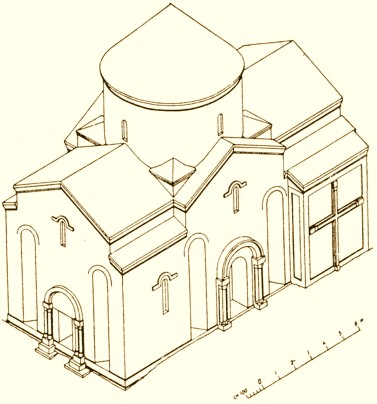
Ani was hailed as the 'The City of 1001 Churches' by the contemporary historians. This number was significant and symbolic of the fact that the City of Ani had numerous beautiful churches of breathtaking grandeur architecture, built by the talented Armenian masons and craftsmen. Armenian master builders like Master Trdat (Tiridates in Latin), the Chief Architect of the Armenian kings and catholicoi (active from the second half of the Xth century to the first half of the XIth) who became renowned throughout Armenia after he designed and built a number of churches and cathedrals throughout Armenia, most notably in Ani. He is credited with the erection of the Church of Argina (973-77), Ani's Mother Cathedral (989-1001 - 12 years to complete the great temple - by far the Master's magnum opus) and the Cathedral of Saint Gregory the Illuminator (1001-10) in the Gagkashen (named after King Gagik) district of the city.
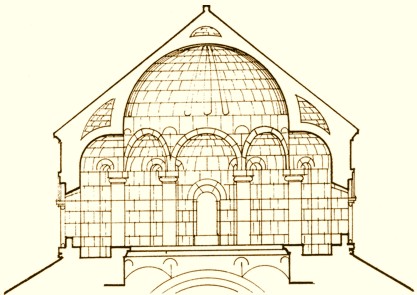
THE CUPOLA OF BANAK/ZVARTNOTS/GAGKASHEN
He is also credited by some scholars with building the Haghpat Monastery of the Surb Nshan (Holy Symbol), the Amenap'rkich' - the Church of the Savior in Sanahin, the Church of Marmashen and also the Church of the Savior and the Walls of Smbatashen, both in Ani. After an earthquake rocked the Byzantine capital of Constantinople, the dome of the marvelous Cathedral of Hagia Sofia (Church of the Divine Wisdom - consecrated by the Emperors to the Eternal Feminine principle) partially collapsed. The Emperor was quick to summon Trdat to restore the dome of the great church, knowing well that the master architect and builder was the best choice for such a difficult task to restore the most loved cathedral in all of Byzantium. It took him almost 4 years (989-92) to restore the dome to its former splendor...
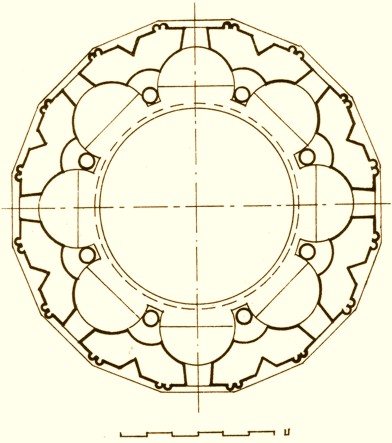
THE FLOOR PLAN OF BANAK/ZVARTNOTS/GAGKASHEN

SECTION OF THE RUINS OF ANI'S WALL ENCLOSURE IN THE EAST.
THE CHURCH OF THE SAVIOR IN THE [LEFT] BACKGROUND.

DUIN OR EREVAN GATE OF ANI.
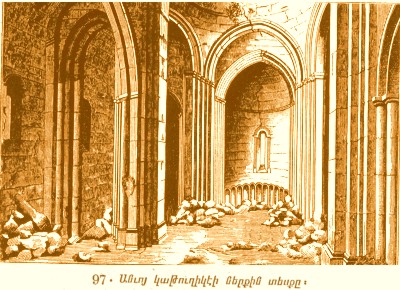
PROTO-GOTHIC FORMS PIONEERED AND APPLIED BY ARMENIAN MASTER
BUILDERS IN
THE MOTHER CHURCH OF ANI.
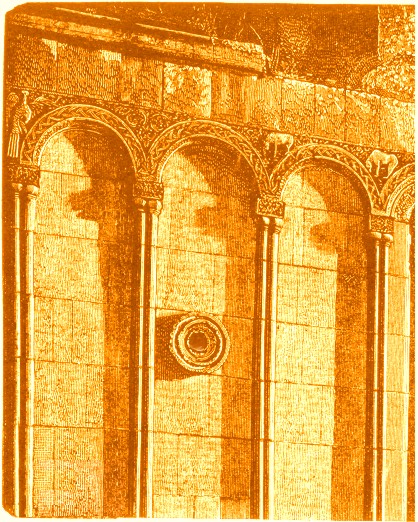
ABOVE AND BELOW: RELIEFS WITH STYLIZED TRADITIONAL ARMENIAN [DOUBLE]
COLUMNS SUPPORTING THE ARCHES DECORATED ARCHES WITH VEGETATIVE AND
NATURE MOTIFS.

...Today the great City of Ani is in ruins... a ghost town, a mere shadow of the once world-renowned splendor of 1000 years ago. The "nick-name" of "ghost town" was not coined by this author, dear reader. It is the name given to abandoned ruins of Ani, in the Turkish travel brochures printed by the Turkish government. It will be impossible for the traveler who is provided with these brochures to find the word 'Armenian' or 'Armenia,' be it in historic or contemporary context. The once crowded streets are no more.
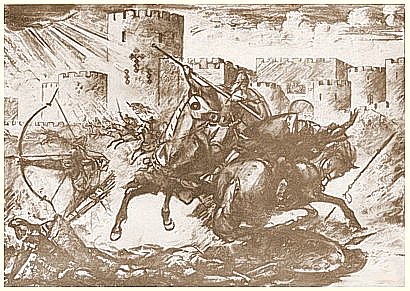
ARMENIAN WARRIORS LED BY VAHRAM SPARAPET FIGHTING NEAR THE GATES
OF ANI

XIXTH CENTURY ENGRAVINGS. A CHURCH NEAR THE MOTHER CATHEDRAL.
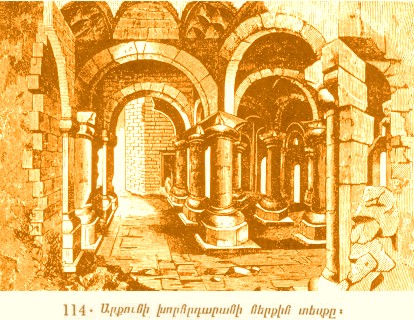
ENTRANCE HALL OF THE CITY COUNCIL BUILDING ADJOINING THE ROYAL
PALACE.
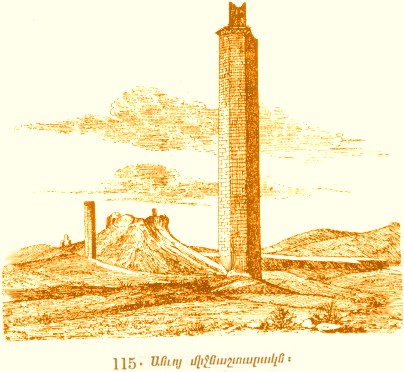
VICTORY OBELISKS CAPPED WITH A CROSS-STONE.
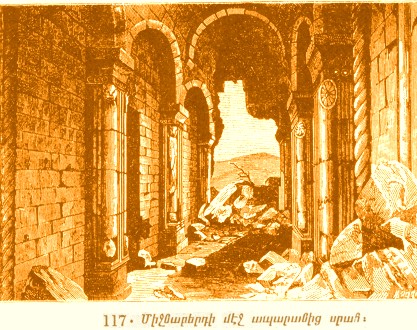
RUINS OF ONE OF THE HALLS IN THE CITADEL.
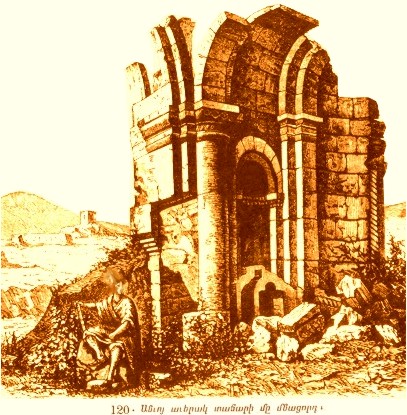
RUINS OF ONE OF THE CATHEDRALS.

RUINS OF A CHURCH.

DOUBLE-FLOOR GATES OF THE PAHLAVUNI OR BAGRATID ROYAL PALACE.
ABOVE FLOOR LAID IN CHECKERED-SQUARE PATTERN WITH TWIN
PILLARS SUPPORTING THE POINTING ARCH [VULVA] WITH INLAID SUNBEAMS
POINTING TO HEXAGRAM PATTERN. BELOW FLOOR WITH EQUAL
ARMED CROSSES FORMING OCTAGRAMS WITH TWIN PILLARS
SUPPORTING THE ARCH WITH OBLONG SQUARES FORMING OCTAGONS.
Only the
decaying remains of the magnificent ruins give the visitor a clue and a glimpse
into a time of civilization, building and advancement, a time when Ani was called the
Great Mother City. Nowadays Armenians from the other side of the Arax river, the
artificially natural state boundary between Republic of Armenia and Western
Armenia, only few miles away watch and hope that someday they can once again
return and rebuild their beloved city. For no one else will care for the
rapidly vanishing city, which can only be restored and once again become
a center of Life, Learning and Civilization by the creative people who built it.
FURTHER READING | HIGHLY RECOMMENDED:
VIRTUAL ANI -- A
TRULY GREAT SITE
SPECIFICALLY DEDICATED TO THE CITY OF ANI
http://www.virtualani.freeserve.co.uk/